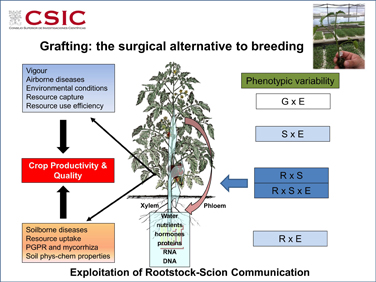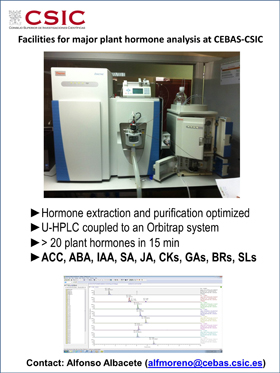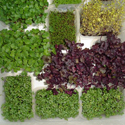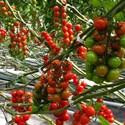Group Plant Nutrición
Lines of research

• Protected plantings: Implementation of new technologies to the control and management of the soil-less cultivation.
The goal of this line of research is to improve the quality of vegetables by the irrigation management and the fertilizers in soil-less cultivation. Through the implementation of new technologies for the management and control of the greenhouses, it is intended to optimize the irrigation management and the fertilizers. For this, we have to take into account the quality of the irrigation used water, as well as the weather conditions in each moment. All that in order to improve the quality of the horticultural products, preventing the pollution derived from this activity. 
• Citrus fruits: Strategies for the water saving and the increase of the resistance to the salinity in lemon tree.
Citrus fruits are one of the most important plantings of the Región de Murcia. However, its production is limited by a growing combination of abiotic stresses such as salinity, drought and boron toxicity, all those generated by the shortage of water resources that our Region suffers. In this context, the general objective of this line of research is to increase the efficient use of water and the fertilizers in order to increase the production and quality of the fruit of citrus fruits cultivated under these adverse environmental conditions. For carrying our this objective, the agronomic and physiological responses of different “pattern-graft” combination of citrus fruits are studied, different strategies of irrigation and fertilization are designed, and different cultivation techniques such as the use of intermediate wood between the variety and the rootstocks, use of shading meshes, etc are evaluated.
• Molecular aspects: Molecular basis of the absorption of K+ and Na+.
K+ is an essential macronutrient to the plants which is absorbed from the soil solution through the roots. In its way to the inside of the plant from the soil solution, the K+ must go through a plasma membrane at some point and for that there are particular transport systems of K+ in the same. In saline conditions, the high concentrations of Na+ make that the entrance of K+ is inhibited at the same time that Na+ comes into plants, by what it is produced K+ differences and Na+ toxicity. For that, the K+ absorption systems, and in particular, its K+/Na+ selectivity are key pieces of the K+/Na+ homeostasis in saline conditions and of the salinity tolerance of the plants.
In this line of research it is used physiological and molecular approaches. On the one hand, the K+ absorption is studied by the plan, its characteristics and how it is influenced by the diverse environmental conditions which can implicate the correct nutrition of K+. On the other hand, genes which encode K+ transport systems of the root implicated in the first step of the nutrient absorption by the plant are identified. In particular, we work with transporters of the HAK family and channels of K+ of the Shaker family such as AKT1. It is studied how the expression of these genes is regulated, where they are expressed and in response to what stimulus or conditions of stress. We work with plants model such as Arabidopsis thaliana or Thellungiella halophila and also with species cultivated such as tomato or pepper.
• Combination of stresses: Multidisciplinary studies in the response of the plants to some simultaneous abiotic stresses.
The agriculture in the south-east, due to its semiarid climate it is negatively affected by some factors such as salinity, high temperatures, water shortage, etc. Until now, most of the abiotic stresses have been studied individually; however plants rarely are subjected to an only stress. In fact, some authors have demonstrated that the combination of environmental stress gives room for unique response which it is not extrapolated when the stresses are applicated individually (Mittler, 2006, Trends in Plant Science). By this way, the general objective that is set out is to study the response of tomato plants to the abiotic stress combination, such as salinity and high temperatures or water shortage and high temperatures. Through transcriptomics and metabolomics studies combined with physiological and biochemical approximations and the use of the biology of systems, the group try to identify exclusive metabolic route of the abiotic stress combination characteristic of our latitudes, such as salinity and high temperatures or water shortage and high temperatures. At the same time, studies of tomato production and quality are carried out under these conditions with the objective of establishing new criterions of fertilizer management.
• Optimization of the source-sink relations and above-ground part root in response to stress: As organisms fixed to the ground, plants have developed a huge metabolic flexibility in order to adapt themselves to adverse stimulus through substantial changes in the primary and secondary metabolism.
One of the key responses is to reorganize the distribution of assimilates between the autotrophic organisms which produce them (sources), and the heterotrophic organisms actively growing which consume them (sinks).
The root, as sensor organ of such stimulus in the ground, is the one in charge of communicating by chemical signals (nutrients and vegetable hormones) with the above-ground part in order to reorganize the source-sink relations, and thus, to adapt themselves to stress. As consequence, these alterations in the above-ground part root communication and in the source-sink relations have profound effects in the growth and development of the plant, and in the productivity and stability of the crops.
 The relationships between source and sink organs determine not only the plant growth and crop yield but also the adaptive capacity to environmental stresses. As a consequence, any mechanism affecting these relations could potentially have an influence on both economic yield and stress tolerance. Since the roots are the first tissues to encounter salt or other osmotic stress, it seems reasonable that they influence shoot physiology by means of root-to-shoot chemical signals (nutrients, hormones) allowing a differential assimilate partitioning and changes in source-sink relationships and affecting other physiological functions (leaf growth and senescence).
The relationships between source and sink organs determine not only the plant growth and crop yield but also the adaptive capacity to environmental stresses. As a consequence, any mechanism affecting these relations could potentially have an influence on both economic yield and stress tolerance. Since the roots are the first tissues to encounter salt or other osmotic stress, it seems reasonable that they influence shoot physiology by means of root-to-shoot chemical signals (nutrients, hormones) allowing a differential assimilate partitioning and changes in source-sink relationships and affecting other physiological functions (leaf growth and senescence).

Our objectives are basic and applied:
1. To go in depth in the knowledge of such physiological processes in relation to the adaptability to diverse ground stresses (eg. Salinity, water shortage, nutrient deficiencies);
2. Exploitation of the natural and biotechnological variability in order to minimize the negative impact which such stresses have on the crop productivity, with special emphasis in the development and application of horticultural rootstocks.






